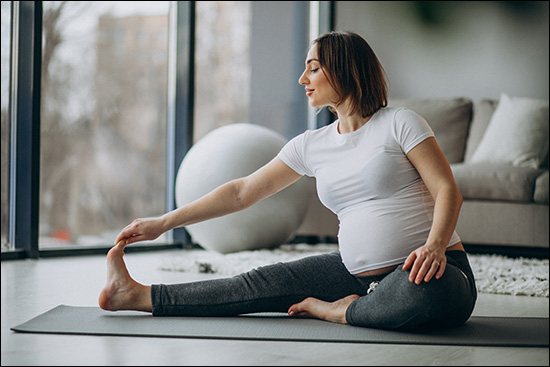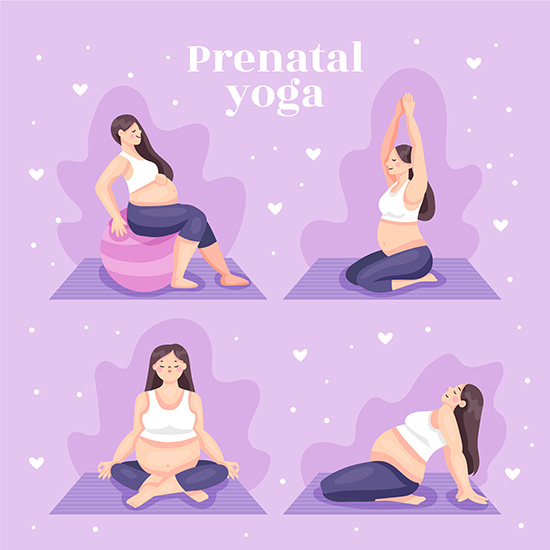Yoga in Pregnancy | Prenatal Yoga Poses for Every Trimester
Abstract
Every pregnancy is different for everyone. While you may experience joy and excitement at the thought of bringing a new life into the world, you may also face feelings of fear, doubt and apprehension about all the changes that will come – in your body and your life, especially at the beginning of pregnancy. Yoga in pregnancy may reduce anxiety, stress and depression in pregnancy. In this article, we are going to discuss different types of yoga poses for different trimesters during pregnancy.

Introduction
Yoga is a breathing exercise and a series of body positions which is helpful in building flexibility, strength and physical well-being. In pregnancy, yoga is beneficial for pregnant women. It keeps women healthy and fresh and gives them strength during pregnancy. The period in which a fetus is developing inside a woman’s womb or uterus is called pregnancy. Pregnancy usually lasts about 40 weeks or just over 9 months, measured from the last menstrual period to delivery.
Stages Of Pregnancy
There Are Three Stages Of Pregnancy:-
- First Trimester
- Second Trimester
- Third Trimester
1. First Trimester
This trimester lasts between 0-13 weeks of pregnancy. During this period, the development of the baby’s body structure and organs. In the first trimester, the fetus is around 3 inches long and weighs nearly 1 ounce. The mother also experiences many changes during the first trimester. These include nausea, vomiting, cravings for certain foods, indigestion, constipation and headache.
2. Second Trimester
This trimester lasts between 14-27 weeks of pregnancy. In this trimester, the fetus is around 1 foot long and weighs 1.5 pounds. In the second trimester, the hair, nail and skin are formed. In this trimester, the first bowel movement developed in the intestine. During this trimester, many women feel more comfortable and also reduce or disappear morning sickness and fatigue. Some changes occur in women like as the fetus grows the abdomen expands and stretch marks may appear on the thigh, abdomen, buttocks and breast.
3. Third Trimester
This trimester lasts between 28 weeks to delivery, which is around 40 weeks. In this trimester, most organs are formed and continue to grow and mature. During this trimester, the bones are hardening, the eyes are opened and movement becomes more noticeable. In women, the discomfort is formed by the growth of the fetus and the women may experience insomnia, shortness of breath, heartburn, swelling in ankles and face, mood swings, frequent urination and anxiety.

Yoga In Different Trimesters During Pregnancy
During pregnancy, it is important to stay active while prioritizing rest. Prenatal yoga offers you the possibility to get in contact with your body even as constructing power, improving flexibility and growing stability. Those benefits can assist in mental and bodily rest, ease pregnant symptoms, and create superb mental patterns.
1. First-Trimester Yoga Poses
In the first trimester, it is important for the woman to maintain her physical activity and also focus on releasing stress and increasing strength. There are some yoga poses which are useful in the first trimester of pregnancy.
a). Janu Sirsasana (Head-To-Knee Forward Bend)
Methods Of Sirsasana
- Sit on the edge of a block, cushion or folded blanket with your right leg extended.
- Place the sole of the right foot against the inner left thigh.
- Inhale as you reach your arms overhead.
- As you exhale, fold forward slightly, lengthening the front of your torso.
- Place your hands on the floor or your body.
- Up to 1-minute stay in this position
- Repeat on the other side.
Benefits Of Sirsasana
- Stimulates digestion
- Strengthen back muscles
- Promotes relaxation
- Stretches legs, hips and back
b). Wide-Angle Seated Forward Bend (Upavistha Konasana)
Methods Of Upavistha Konasana
- Sit on the edge of a block, cushion or folded blanket, with your legs out to the side, allowing your pelvis to tilt forward.
- Reach arms overhead.
- Bend at the hips as you fold forward.
- Place your hands in front of you or take hold of your big toes.
- Up to 1 minute hold this position.
Benefits Of Upavistha Konasana
- Promotes flexibility of lower legs and hips
- Promotes flexibility of the lower back
- Strengthen the lower back and spine
- Strengthen pelvic
c). Marjaryasana To Bitilasana (Cat-Cow Pose)
Methods Of Marjaryasana To Bitilasana
- Place your palms on the floor in front of you..
- Palms shoulder-width apart, knees directly under hips.
- Take a deep breath while arching your lower back and lifting your head, tilting your pelvis up like a "cow".
- Take a deep breath and pull in your belly, arch your spine and pull your head and pelvis down like a "cat".
- Repeat several times
Benefits Of Marjaryasana To Bitilasana
- Boost circulation
- Relieve tension
- Improves spinal mobility
Precautions During Yoga In The First Trimester
In the first trimester, pregnant women should avoid excessive forward bend and intense backbends, twisting, jumping, hot yoga and forceful or strong abdominal contraction.
2. Second Trimesters Yoga Poses
In the second trimester, the relaxin hormone is produced by women’s bodies at a higher level. It relaxes muscles, ligaments and tendons to prepare pregnant women’s bodies for birth. There are some yoga poses which are useful in the second trimester of pregnancy.
a). Baddha Konasana (Bound Angle Pose)
Methods Of Baddha Konasana (Bound Angle Pose)
- Sit on the edge of a cushion, folded blanket or block, allowing your pelvis to tilt forward.
- Press the soles of your feet together.
- For deepening the stretch bring your feet in toward the hips.
- As you lengthen your spine, root your lower body into the floor.
- Place hands on your ankles.
- Up to 1 minute hold this position
- Repeat this 2-4 times.
Benefits Of Baddha Konasana
- Stimulates digestive organs
- Boost circulation
- Promotes relaxation
- Improves flexibility of inner thighs and lower back
b). Balasana (Child Pose)
Methods Of Balasana (Child’s Pose)
- Touch big toes together and spread knees
- Lower your hips back onto your heels.
- Reach arms in front of you.
- Breathe deeply.
- Up to 1 minute hold this pose.
Benefits Of Balasana
- Stretches your chest, shoulder and lower back
- Enhance flexibility of thighs and hips
- Enhance flexibility of the spine
c). Trikonasana (Triangle Pose)
Methods Of Trikonasana (Triangle Pose)
- Start in a standing position.
- Step your right foot forward to widen your stance. The right foot’s toes are pointed ahead. For no bend, keep the left knee straight.
- Slightly angle the left foot, so there is more stability.
- Open your hips by rotating your hips and torso from the center to the left.
- Slowly reach the right arm down towards the right ankle. Here you have the option to place the right on a block the inside of your right leg, on your leg or on the floor.
- Reach the left arm up above the left shoulder.
- For up to 30 seconds hold this pose.
- Repeat on the other side.
Benefits Of Trikonasana
- Gives a burst of energy
- Relieving back tension
- Relieving neck tension
d). Uttanasana (Standing Forward Bend)
Methods Of Uttanasana (Standing Forward Bend)
- Stand with feet slightly wider than hips.
- Hinge at your hips to fold forward.
- Keep knees slightly bent.
- Place hands on the floor
- For up to 30 seconds hold this pose
Benefits Of Uttanasana
- Promote inner calm
- Relieves tension
Precautions During Yoga In The Second Trimester
In the second trimester, Pregnant women should avoid lying on their back or right side, forceful abdominal contractions, hot yoga and jumping.
3. Third Trimesters Yoga Poses
In the third trimester, pregnant women may have difficulty in breathing because the baby is now taking up more space. There are some yoga poses which are useful in the third trimester of pregnancy.
a). Virabhadrasana-II (Warrior-II)
Methods Of Virabhadrasana-II (Warrior-II)
- From standing, step your right foot back and turn your toes out to the right slightly.
- Align the inside of the right foot so it’s in line with the left heel.
- Open your hips to face the side.
- With palms facing downward, raise your arms to be parallel to the floor.
- Bend your left knee, making sure it doesn’t extend past your ankle.
- Gaze over your front middle finger.
- For up to 30 seconds hold this pose
- Repeat on the other side.
Benefits Of Virabhadrasana-II
- Strengthen whole body
- Relieves back and neck pain
- Opens the hips
- Improves circulation
b). Malasana (Garland Pose)
Methods Of Malasana (Garland Pose)
- Stand with feet slightly wider than hip-width apart and toes angled outward.
- Slowly lower your hips with bend your knees
- Lift your heels or place them on the floor.
- At the center of your chest press palms together.
- Press elbows and knees.
- Up to 30 seconds hold this position.
Benefits Of Malasana
- Open hips
- Boosts digestion, avoid if you are prone to prolapse
c). Sukhasana (Easy Pose)
Methods Of Sukhasana (Easy Pose)
- Sit on the edge of a cushion, folded blanket or block, allowing your pelvis to tilt forward.
- Circulate your left leg over your right leg.
- Place your hands in any comfortable position.
- Close your eyes and breathe deeply.
- Up to 1 minute hold this position.
- Repeat on the other side.
Benefits Of Sukhasana
- Promote mental clarity
- Lengthens your spine
d). Parsva Savasana (Side Corpse Pose)
Methods Of Parsva Savasana (Side Corpse Pose)
- Lie on your left side.
- Keep your left leg straight.
- Bend your right knee and support it with cushions.
- Place a cushion under your head.
- For 15 minutes relax in this position.
Benefits Of Parsva Savasana
- Enhances relaxation
- Relieves fatigue
Precautions During Prenatal Yoga
- During all poses make sure you can breathe easily.
- Stop practicing if you feel nauseated
- Stop practicing if you are overheated
- Stop practicing if you feel dehydrated
- Stop practice if you experience unusual spotting and vaginal discharge.
- Stop practicing if you have numbness.
Conclusion
In pregnancy, prenatal yoga is beneficial for shorter labor and vaginal delivery. Yoga in pregnancy may reduce anxiety, stress and depression in pregnancy. Yoga is a breathing exercise and a series of body positions which is helpful in building flexibility, strength and physical well-being. In this article, we discussed different yoga poses for different trimesters. For the healthy wellbeing of both mother and baby yoga is beneficial. It is also helpful in normal delivery.



